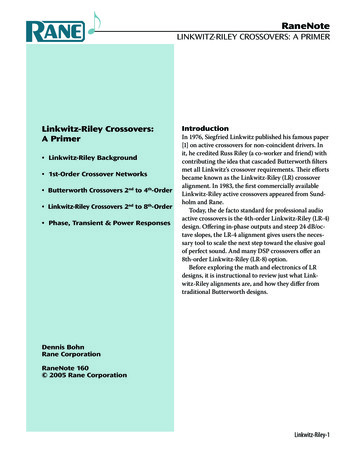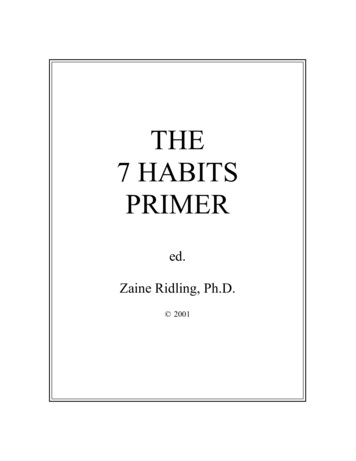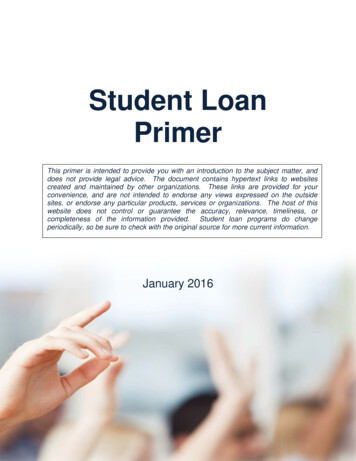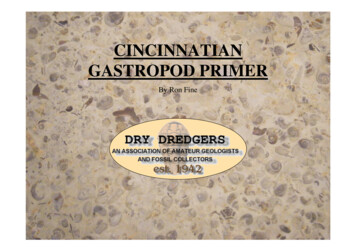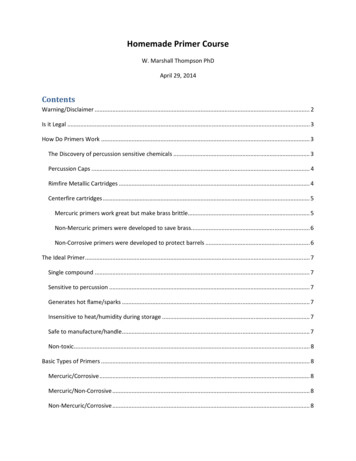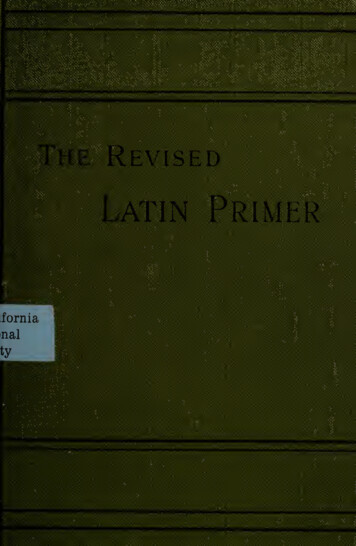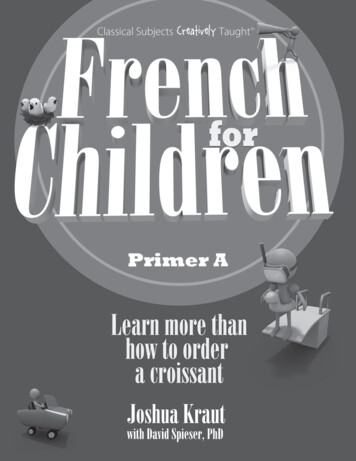
Transcription
French for Children Primer A Classical Academic Press, 2015Version 1.0ISBN: 978-1-60051-279-7All rights reserved. This publication may not be reproduced,stored in a retrieval system, or transmitted, in any form or by any means,without the prior written permission of Classical Academic Press.Classical Academic Press2151 Market StreetCamp Hill, PA 17011www.ClassicalAcademicPress.comIllustrations by Jason RaynerBook design by Lauraine GustafsonNotebook image courtesy of designious/Vecteezy.comLadder image courtesy of freevector/Vecteezy.comPGP.06.15
RRDÉdicaceFor Mme. Scott, whose generosity, talent, and enthusiasm in the classroomformed the perfect environment for a love of language to grow.Et pour David, mon policier personnel de l’orthographe,mon consultant, mais surtout mon frère et mon ami.
RRTABLE OF CONTENTSTitlePageCD Track & Audio File InformationviPronunciation Wizard9Suggested Schedule1Introduction5PartieChapitreChant11Je parle (I speak, I am speaking) Verbs4Subject Pronouns23235Review; Hidden Mysteries of Pronouns, Part 2 73J’ai, Avoir (I have, to have)10Review12Verb Endings; Infinitives; Faux AmisSubject Pronouns vs. Subjects; HiddenMysteries of Pronouns, Part 159Irregular Verbs, Part 1: Avoir; Un/Une andDes; Definite and Indefinite Articles104GenderArticles; Subject Pronouns; HiddenMysteries of Pronouns, Part 3PluralsTricky Plurals; The Curious Haves, Part 1Un chien sympathique(A nice dog)Adjectives; Word Order Using Adjectives;The Curious Haves, Part 3143179The Forms of DeReviewThe Daring De; The Curious Haves, Part 2Adjective Agreement15Mon, ma, mes (My)Possessive Adjectives174682Amusant, amusants (Funny)1635Nouns; Gender1314TitleReviewFinir (to finish)81125Subjects; Verbs: Number; Verbs: PersonLe and La (The)9PageParler (to speak/talk)67Grammar TopicsBon et beau (Good andbeautiful)ReviewEnd-of-Book ReviewBAGS Adjectives; Three Tricky FeminineAdjectives; The Curious Haves, Part e by Chapter205Appendix A: Dialogue Translations226Alphabetical VocabulaireCategorical VocabulaireAppendix B: Chant TranslationsAppendix C: PrepositionsAppendix D: Verbs213219240244245
CD Track & Audio File InformationCD AudioTrack File Chap. Page12345678910111213141516171819202122230PW 010PW 020PW 030PW 040PW 050PW 060PW 070PW 080PW 090PW 100PW 110PW 120PW 130PW 140PW 150PW 160PW 170PW 180PW 190PW 200PW 210PW 220PW 03 053587712 0312144134204 034608013 PW 24PW232701 0312626282930313233343536373801 0101 0201 0401 0502 0102 0202 0302 0402 0503 0103 0203 0303 041111222223333CD AudioTrack File Chap. Page92425CD AudioTrack File Chap. 7604 01404 02404 04404 05405 01506 01606 02606 03606 04606 05607 01707 02707 03707 04707 0507 0608 03809 01909 02909 03909 04909 05909 06909 07910 011011 031111 011111 021111 041111 051112 0112 0212vi80828283839293949495105808 05728808 0460100808 02607708 969712 0412 0513 0213 0313 0413 0513 0613 0714 0114 0214 0314 0414 0514 0615 0115 0215 0315 0415 54154156160167168169169169174178179180180181190
RRSuggested ScheduleThere are seventeen chapters in French for Children Primer A, of which thirteen are contentchapters and four are review. Doing one chapter per week (content and review chapters) willallow you to finish the course in approximately half of an academic year. Alternatively, if youcomplete one content chapter every two weeks, taking just one week per review chapter, thecourse will take a full year—thirty weeks.Weekly ScheduleThe following is a basic weekly schedule, to be modified as necessary by the teacher. Notethat days two and five call for longer sessions.Day One (approx. 30 mins.)Listen to the audio file of the opening dialogue and have students follow along in thetext. Take a few minutes (not too long) to ask students what they’ve understood from thedialogue and what they think is going on. Comprehension at this stage may be very minimal,but students should be encouraged to guess at details of the plot or simply the meaning of asingle word. Present the vocabulary and the paradigm (grammar chant). Students should chantthrough the paradigm and vocabulary two or three times, using the recorded audio files (and/or teachers’ pronunciation) as a guide. (Optional step 1: At this point, the video can be playedup to the point at which the instructor reads through the chant and the vocabulary, but thevideo should be stopped after that.) Then, ask students to skim back over the dialogue to see ifthey understand more of the French. Again, do not take too long for comprehension questionsat this stage; the dialogue will be revisited later. (Optional step 2: Students can take turnsreading different parts in the dialogue, one or two lines each. This activity is meant to helpstudents read the French and develop good French pronunciation more than to stage a drama,since comprehension may still be minimal.)Day Two (approx. 55–65 mins.)Review the paradigm (grammar chant) and vocabulary and have students chant them againone or two times. Watch the video (either picking up where you left off from day one or viewingit in its entirety). The videos are approximately forty-five minutes to an hour in length. Whileyou should feel free to stop them and rewind at any time, be aware that they may take a whileto get through with frequent interruptions.1
Day Three (approx. 30 mins.)Start with a quick chant of the paradigm and vocabulary. Then spend some time explainingthe grammar page, paying special attention to the examples. If you see an italicized sentence,be sure to emphasize it (you may consider having students circle these and other key sentenceswith a colored pencil for future reference). Ask comprehension questions, such as “Can youtell me how a French adjective is different from an English adjective?” or “What is a pronoun?”After this, begin the worksheet, or assign it as homework.Day Four (approx. 30 mins.)Again, start the day with a quick chant of the paradigm and vocabulary. Next, the worksheetshould either be started or completed. Check students’ work and go over any corrections withthe students. Grammar should be reviewed and retaught as necessary. One means of reviewinggrammar can be to view the video again to ensure comprehension of key grammatical topics forthat chapter.Day Five (approx. 50 mins.)Students should take the quiz without looking back at the rest of the chapter. When thequiz has been completed, go over the answers together and review any trouble spots. Finally,go back and listen to the opening dialogue once more, having students follow along in thetext. Discuss what is happening, and identify vocabulary/grammatical points that help youunderstand the dialogue. Translate the dialogue together.Biweekly ScheduleThe following is a basic biweekly schedule spread over seven class meetings, to be modifiedas necessary by the teacher.Day One (approx. 30 mins.)Listen to the opening dialogue and follow along in the text. Take a few minutes (not toolong) to ask students what they’ve understood from the dialogue, and what they think is goingon. Comprehension at this stage may be very minimal, but students should be encouraged toguess at details of the plot or simply the meaning of a single word. Present the vocabulary andthe paradigm (grammar chant). Students should chant through the paradigm and vocabularytwo or three times, using the recorded audio files (and/or teachers’ pronunciation) as a guide.(Optional step 1: At this point, the video can be played up to the point at which the instructorreads through the chant and the vocabulary, but it should be stopped after that.) Then, askstudents to skim back over the dialogue to see if they understand more of the French. Again, do2Suggested Schedule
not take too long for comprehension questions at this stage; the dialogue will be revisited later.(Optional step 2: Students can take turns reading different parts in the dialogue, one or twolines each. This activity is meant to help students read and develop good French pronunciationmore than to stage a drama, since comprehension may still be minimal.Day Two (approx. 55–65 mins.)Review the paradigm (grammar chant) and vocabulary and have students chant them againone or two times. Have students watch the video (either picking up where you left off from dayone, or else in its entirety). The videos are between forty-five minutes and an hour in length.While you should feel free to stop them and rewind at any time, be aware that they may take awhile to get through with frequent interruptions.Day Three (approx. 30 mins.)Start with a quick chant of the paradigm and vocabulary. Then spend some time explainingthe grammar page, paying special attention to the examples. If you see an italicized sentence,be sure to emphasize it (you may consider having students circle or highlight these and otherkey sentences for future reference). Ask comprehension questions, such as “Can you tell mehow a French adjective is different from an English adjective?” or “What is a pronoun?” Go backand listen to the opening dialogue once more, having students follow along in the text. Discusswhat is happening, and identify vocabulary/grammatical points that help you understand thedialogue (a full translation is not necessary at this time—target in particular those sectionsof the dialogue that employ grammatical notions discussed in the Grammar section). If timeremains, have students begin the worksheet.Day Four (approx. 30 mins.)Again, start the day with a quick chant of the paradigm and vocabulary. Next, the worksheetshould be started. Students may consult the chapter to complete this section. Grammar shouldbe reviewed and retaught as necessary. One means of reviewing grammar can be to view partsof the video again to ensure comprehension of key grammatical topics for that chapter.Day Five (approx. 30 mins.)The worksheet should be completed and reviewed. Trouble spots should be addressed.Students should prepare for taking the quiz by playing vocabulary games (e.g., flash cards,bingo, charades, etc.). Visit HeadventureLand.com for the fun, fast-paced, and free vocabularygame, FlashDash.Suggested Schedule3
Day Six (approx. 30 mins.)Have students take the quiz, noting that they are not to look back at the previous sections ofthe chapter.Day Seven (approx. 30 mins.)Review the quiz. Then, return a final time to the opening dialogue, having students listento the audio file and follow along in the text. Translate the dialogue together. Discuss what ishappening and identify vocabulary/grammatical points that help you understand the dialogue.Students may be encouraged to read aloud and to do their best to “act the part” if they feel soinclined.4Suggested Schedule
RRINTRODUCTIONBefore beginning our first lesson, let’s talk about how this book works. The first thing you’llencounter after this introduction is the Pronunciation Wizard. This fairly self-explanatorywizard will be used over the course of the first few chapters. It is first mentioned in theWorksheet section of chapter 1. Even after you’ve finished with it (in chapter 5), feel free to flipback to it or listen again to the audio files for any questions you may have about the wonderfulworld of French pronunciation.After the Pronunciation Wizard, you’ll find the actual chapters of the book. There are twotypes of chapters: lesson chapters and review chapters. Review chapters are the easiest toexplain. They simply bring together the information you’ve seen in the previous few chaptersand give you an opportunity to test your knowledge. Lesson chapters, then, are where you learnthings for the first time.In each lesson chapter, you will see a few things: At the top of each page in the lessonchapters, you will see different titles. The title that is BIGGER THAN THE REST tells you whichpart of a chapter you are in. The four main parts of each lesson chapter are: Memory, Grammar,Worksheet, and Quiz. Let’s take a look at what you’ll find in each of the different parts.MemoryDialogue:The dialogues in this book weave together a somewhat peculiar story. Without revealing toomuch here in the introduction, we shall simply say that they relate the adventures of two fourlegged companions of considerably different sizes and their meetings with other animals, aswell as occasional people, whom they encounter along their way.The Fables of Jean de La Fontaine, if you know them, may come to mind as you read throughthe dialogues—not every dialogue, but a good number of them. Many of these fables havean even earlier author with whom you may be familiar: the Greek poet, Aesop. A number ofAesop’s fables were adapted by La Fontaine (in French, of course) almost 2,000 years after theywere originally written!5
More practically, the dialogues introduce you to some of the new vocabulary that you’ll belearning in each chapter. Feel free to read over the chapter’s vocabulary list before reading thedialogue if you desire, but we do not recommend that you try to memorize it letter-for-letterbefore attempting to read the dialogues.In fact, the most rewarding way to approach the dialogues may simply be to jump right in andtry to figure out what words mean by their context. You will often see a mix of French and Englishin the dialogues—especially at the beginning of the book—which should help you understandthe context of the conversation better. In many cases, this mixture of languages should also makeit possible for you to decipher the new French words in each chapter. Even if you can only narrowit down to a guess (for example: “I think this word must be some kind of food,” or “I think thisword is an action th
There are seventeen chapters in French for Children Primer A, of which thirteen are content chapters and four are review. Doing one chapter per week (content and review chapters) will allow you to finish the course in approximately half of an academic year. Alternatively, if you complete one content chapter every two weeks, taking just one week per review chapter, the course will take a full .
